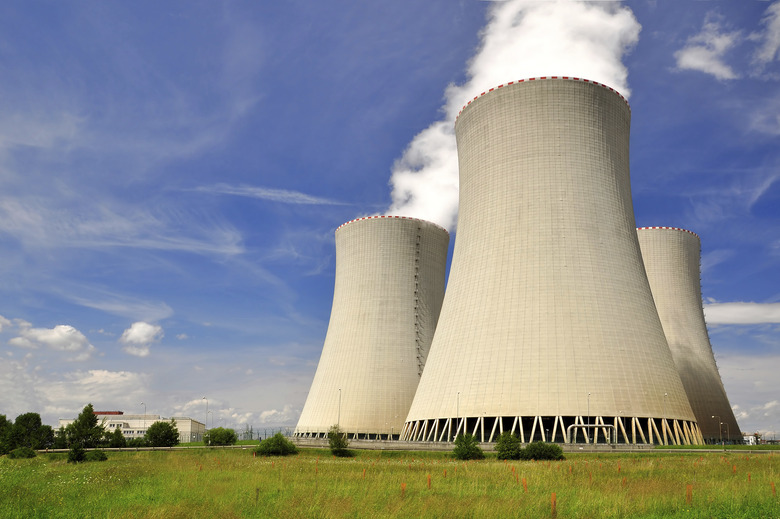Is Nuclear Energy Renewable Or Nonrenewable?
Because windmills and solar panels operate using the wind and sun, those two energy sources are renewable — they will not run out. Oil and gas, on the other hand, are finite, nonrenewable and will not exist one day. You could classify nuclear energy as nonrenewable because uranium and similar fuel sources are finite. On the other hand, some people consider nuclear energy renewable because the element thorium and other new technologies may provide practically inexhaustible fuel sources needed to power nuclear reactors.
Fission: Energy Locked In Atoms
Fission: Energy Locked In Atoms
A nuclear reactor generates electricity by splitting atoms in a process called fission. When an atom splits, energy is released along with neutrons that strike other atoms, causing them to release more neutrons and energy. The reactor uses the energy's heat to warm water that produces steam. That steam drives generators that produce the electricity the power plant distributes to customers. Most reactors use uranium as the fuel source. Nuclear power plants also produce nuclear waste that they must dispose of safely. This waste consists of extremely radioactive materials that remain after used nuclear fuel is no longer capable of producing electricity efficiently.
What is Renewable Energy?
What is Renewable Energy?
The Library of Congress defines renewable energy as "a sustainable energy source that is replaced rapidly, by a natural ongoing process." Non-renewable energy resources are depleted more quickly than they are replenished, and they will run out based on our current rate of consumption.
Renewable resources, especially in the search for clean energy, are incredibly important in working to counteract and prevent further damage from climate change. Resources like geothermal energy, hydropower, wind turbines, hydroelectric power, and solar energy are all renewable energy sources that draw power from continually replenishing origins. Current energy production is heavily reliant on fossil fuels which produce significant greenhouse gas emissions.
The LOC notes that nuclear fuel sources are "not essentially renewable" — they can be depleted. The U.S. Department of Energy classifies uranium as non-renewable resource.
We can certainly draw a definite line around fossil fuels as a non-renewable resource, but not all energy sources that produce greenhouse gas and carbon emissions are non-renewable energy sources. Biomass is a renewable source of energy created from organic matter, which is then combusted. It still creates carbon dioxide, methane, and other emissions in addition to air pollution. Biomass is carbon neutral, but it still falls into many of the same dangers as traditional fossil fuels.
How is Nuclear Energy Produced?
How is Nuclear Energy Produced?
Modern nuclear energy is produced through a process of nuclear fission with uranium fuel. Neutrons collide with uranium atoms which then split into more neutrons and decay products to repeat the process; each split produces a fairly large amount of energy which is then used in nuclear power generation. The exact methods can vary, but – often – fuel rods made of uranium undergo nuclear fission, and the resulting energy is used to heat water into steam. The steam then turns a turbine in the nuclear plant to create electricity.
This process does create radioactive waste, typically in the form of another uranium isotope, plutonium, and other potentially radioactive materials. The radioactive waste must be stored responsibly and for a fairly long period of time (anywhere between many decades to many hundreds of years) before it becomes inert and safe.
The Great Nuclear Energy Debate
The Great Nuclear Energy Debate
Experts still question whether the world should call nuclear power a "renewable" energy resource. Those who want to classify nuclear energy as renewable cite the fact that it has low carbon emission — just the way renewable sources such as wind and solar do. Non-renewable fuels, such as natural gas and oil, produce byproducts that harm the environment through global warming emissions. Those opposed to calling nuclear power renewable note that nuclear power plants create harmful waste.
Arguments For Nuclear Power Renewability
Arguments For Nuclear Power Renewability
According to some experts, breeder reactors could produce enough fissile material to last forever. Breeder reactors use neutrons released by fission to create other nuclear plutonium and other types of fuel. One of plutonium's disadvantages is its potential use as a nuclear weapon. Thor Energy in Norway successfully used thorium in a nuclear reactor to generate energy. Thorium — a radioactive metal found in almost all plants, water and soil — is safer than uranium and not susceptible to nuclear proliferation. A cleaner, safer nuclear reactor could answer critics who don't call nuclear energy renewable because it produces waste products.
References
- Stanford University: Is Nuclear Energy Renewable Energy?
- Union of Concerned Scientists: Benefits of Renewable Energy Use
- U.S. Department of Energy: Power to the Plug – An Introduction to Energy, Electricity, Consumption and Efficiency
- Extreme Tech: Thorium Nuclear Reactor Trial Begins, Could Provide Cleaner, Safer, Almost-waste-free Energy
- U.S. Environmental Protection Agency: Thorium | Radiation Protection
- Library of Congress BERA: The Oil & Gas Industry – Alternative Energy Sources (Business Reference Services, Library of Congress)
- U.S. Nuclear Regulatory Commission
Cite This Article
MLA
Lee, Kevin. "Is Nuclear Energy Renewable Or Nonrenewable?" sciencing.com, https://www.sciencing.com/nuclear-energy-renewable-nonrenewable-4579290/. 5 June 2023.
APA
Lee, Kevin. (2023, June 5). Is Nuclear Energy Renewable Or Nonrenewable?. sciencing.com. Retrieved from https://www.sciencing.com/nuclear-energy-renewable-nonrenewable-4579290/
Chicago
Lee, Kevin. Is Nuclear Energy Renewable Or Nonrenewable? last modified June 5, 2023. https://www.sciencing.com/nuclear-energy-renewable-nonrenewable-4579290/
